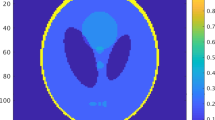Abstract
Although the filtered backprojection algorithm (FBA) has been the standard reconstruction algorithm in 2D computerized tomography for more than 30 years, its convergence behavior is not completely settled so far. Relying on convergence results by Rieder and Faridani for the semi-discrete FBA [SIAM J. Numer. Anal., 41(3), 869–892, 2003], we show optimality of the fully discrete version for reconstructing sufficiently smooth density distributions. Further, we introduce MFBA, a modified version of FBA, and prove its optimality under weaker smoothness requirements. Remarkably MFBA may have a larger convergence order in the angular than in the lateral variable, thus allowing optimal convergence in case of angular under- sampling. Moreover, MFBA can be seen as a limit of the phantom view method introduced to increase angular resolution.
Similar content being viewed by others
References
Aubin J.-P. (2000). Applied Functional Analysis, Pure & Applied Mathematics. Wiley, New York
Brenner, S.C., Scott, L.R.: The Mathematical Theory of Finite Element Methods, vol. 15 of Texts in Applied Mathematics. Springer, New York (1994)
Galigekere R.R., Wiesent K. and Holdsworth D.W. (1999). Techniques to alleviate the effects of view aliasing artifacts in computed tomography. Med. Phys. 26: 896–904
Giusti E. (1984). Minimal Surfaces and Functions of Bounded Variation. Birkhäuser, Basel
Kress, R.: Numerical Analysis, vol. 181 of Graduate Texts in Mathematics. Springer, New York (1998)
Lewitt R.M., Bates R.H.T. and Peters T.M. (1978). Image reconstruction from projections II: Modified backprojection methods. Optik 50: 85–109
Lions J.L. and Magenes E. (1972). Non-Homogeneous Boundary Value Problems and Applications, Vol. 1. Springer, New York
Louis A.K. and Natterer F. (1983). Mathematical problems in computerized tomography. Proc. IEEE 71: 379–389
Natterer, F.: Genauigkeitsfragen bei der numerischen Rekonstruktion von Bildern, vol. 49 of International series of numerical mathematics (ISNM), Birkhäuser Verlag, Basel, Switzerland, pp. 131–146 (1979)
Natterer F. (1980). A Sobolev space analysis of picture reconstruction. SIAM J. Appl. Math. 39: 402–411
Natterer F. (1986). The Mathematics of Computerized Tomography. Wiley, Chichester
Rieder A. and Faridani A. (2003). The semi-discrete filtered backprojection algorithm is optimal for tomographic inversion. SIAM J. Numer. Anal. 41: 869–892
Rieder A. and Schuster Th. (2000). The approximate inverse in action with an application to computerized tomography. SIAM J. Numer. Anal. 37: 1909–1929
Schneck, A.: Konvergenz von Rekonstruktionsalgorithmen in der 2D-Tomographie: Der voll-diskrete Fall (Convergence of reconstruction algorithms in 2D-tomography: The fully discrete case). Diploma thesis, Fakultät für Mathematik, Universität Karlsruhe, D-76128 Karlsruhe, Germany (2006)
Shepp L.A. and Logan B.F. (1974). The Fourier reconstruction of a head section. IEEE Trans. Nucl. Sci. 21: 21–43
Smithey D.T., Beck M., Raymer M.G. and Faridani A. (1993). Measurement of the Wigner distribution and the density matrix of a light mode using optical homodyne tomography: application to squeezed states and the vacuum. Phys. Rev. Lett. 70: 1244–1247
Weiss G.H., Talbert A.J. and Brooks R.A. (1982). The use of phantom views to reduce CT streaks due to insufficient sampling. Phys. Med. Biol. 27: 1151–1162
Author information
Authors and Affiliations
Corresponding author
Rights and permissions
About this article
Cite this article
Rieder, A., Schneck, A. Optimality of the fully discrete filtered backprojection algorithm for tomographic inversion. Numer. Math. 108, 151–175 (2007). https://doi.org/10.1007/s00211-007-0109-7
Received:
Revised:
Published:
Issue Date:
DOI: https://doi.org/10.1007/s00211-007-0109-7




